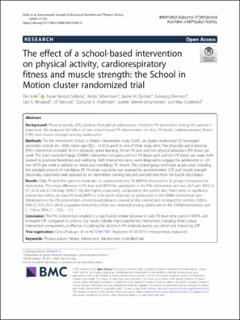| dc.contributor.author | Kolle, Elin | |
| dc.contributor.author | Solberg, Runar Barstad | |
| dc.contributor.author | Säfvenbom, Reidar | |
| dc.contributor.author | Dyrstad, Sindre Mikal | |
| dc.contributor.author | Berntsen, Sveinung | |
| dc.contributor.author | Resaland, Geir Kåre | |
| dc.contributor.author | Ekelund, Ulf | |
| dc.contributor.author | Anderssen, Sigmund Alfred | |
| dc.contributor.author | Steene-Johannessen, Jostein | |
| dc.contributor.author | Grydeland, May | |
| dc.date.accessioned | 2021-01-27T05:19:41Z | |
| dc.date.available | 2021-01-27T05:19:41Z | |
| dc.date.created | 2020-12-14T16:30:57Z | |
| dc.date.issued | 2020 | |
| dc.identifier.citation | International Journal of Behavioral Nutrition and Physical Activity. 2020, 17, 154. | en_US |
| dc.identifier.issn | 1479-5868 | |
| dc.identifier.uri | https://hdl.handle.net/11250/2724873 | |
| dc.description | This article is licensed under a Creative Commons Attribution 4.0 International License, which permits use, sharing, adaptation, distribution and reproduction in any medium or format, as long as you give appropriate credit to the original author(s) and the source, provide a link to the Creative Commons licence, and indicate if changes were made. The images or other third party material in this article are included in the article's Creative Commons licence, unless indicated otherwise in a credit line to the material. If material is not included in the article's Creative Commons licence and your intended use is not permitted by statutory regulation or exceeds the permitted use, you will need to obtain permission directly from the copyright holder. To view a copy of this licence, visit http://creativecommons.org/licenses/by/4.0/. The Creative Commons Public Domain Dedication waiver (http://creativecommons.org/publicdomain/zero/1.0/) applies to the data made available in this article, unless otherwise stated in a credit line to the data. | en_US |
| dc.description.abstract | Background: Physical activity (PA) declines throughout adolescence, therefore PA promotion during this period is important. We analyzed the effect of two school-based PA interventions on daily PA levels, cardiorespiratory fitness (CRF) and muscle strength among adolescents.
Methods: For the nine-month School in Motion intervention study (ScIM), we cluster-randomized 30 Norwegian secondary schools (N = 2084, mean age [SD] = 14 [0.3] years) to one of three study arms. The physically active learning (PAL) intervention included 30 min physically active learning, 30 min PA and a 60 min physical education (PE) lesson per week. The Don’t worry-Be happy (DWBH) intervention included a 60 min PA lesson and a 60 min PE lesson per week, both tailored to promote friendships and wellbeing. Both intervention arms were designed to engage the adolescents in 120 min of PA per week in addition to recess and mandatory PE lessons. The control group continued as per usual, including the standard amount of mandatory PE. PA (main outcome) was assessed by accelerometers, CRF and muscle strength (secondary outcomes) were assessed by an intermittent running test and selected tests from the Eurofit test battery.
Results: Daily PA and time spent in moderate- to vigorous-intensity PA (MVPA) decreased in all groups throughout the intervention. The mean difference in PA level and MVPA for participants in the PAL-intervention arm was 34.7 cpm (95% CI: 4.1, 65.3) and 4.7 min/day (95% CI: 0.6, 8.8) higher, respectively, compared to the control arm. There were no significant intervention effects on daily PA level, MVPA or time spent sedentary for adolescents in the DWBH-intervention arm. Adolescents in the PAL-intervention arm increased distance covered in the running test compared to controls (19.8 m, 95% CI: 10.4, 29.1), whilst a negative intervention effect was observed among adolescents in the DWBH-intervention arm (− 11.6 m, 95% CI: − 22.0, − 1.1).
Conclusion: The PAL-intervention resulted in a significantly smaller decrease in daily PA level, time spent in MVPA, and increased CRF compared to controls. Our results indicate that a teacher-led intervention, including three unique intervention components, is effective in curbing the decline in PA observed across our cohort and improving CRF. | en_US |
| dc.language.iso | eng | en_US |
| dc.subject | physical activity | en_US |
| dc.subject | fitness | en_US |
| dc.subject | adolescents | en_US |
| dc.subject | randomized controlled trial | en_US |
| dc.title | The effect of a school-based intervention on physical activity, cardiorespiratory fitness and muscle strength: The School in Motion cluster randomized trial | en_US |
| dc.type | Peer reviewed | en_US |
| dc.type | Journal article | en_US |
| dc.description.version | publishedVersion | en_US |
| dc.rights.holder | © The Author(s). 2020 | en_US |
| dc.source.pagenumber | 14 | en_US |
| dc.source.volume | 17 | en_US |
| dc.source.journal | International Journal of Behavioral Nutrition and Physical Activity | en_US |
| dc.identifier.doi | 10.1186/s12966-020-01060-0 | |
| dc.identifier.cristin | 1859685 | |
| dc.description.localcode | Institutt for idrettsmedisinske fag / Department of Sports Medicine | en_US |
| dc.source.articlenumber | 154 | en_US |
| cristin.ispublished | true | |
| cristin.fulltext | original | |
| cristin.qualitycode | 2 | |
